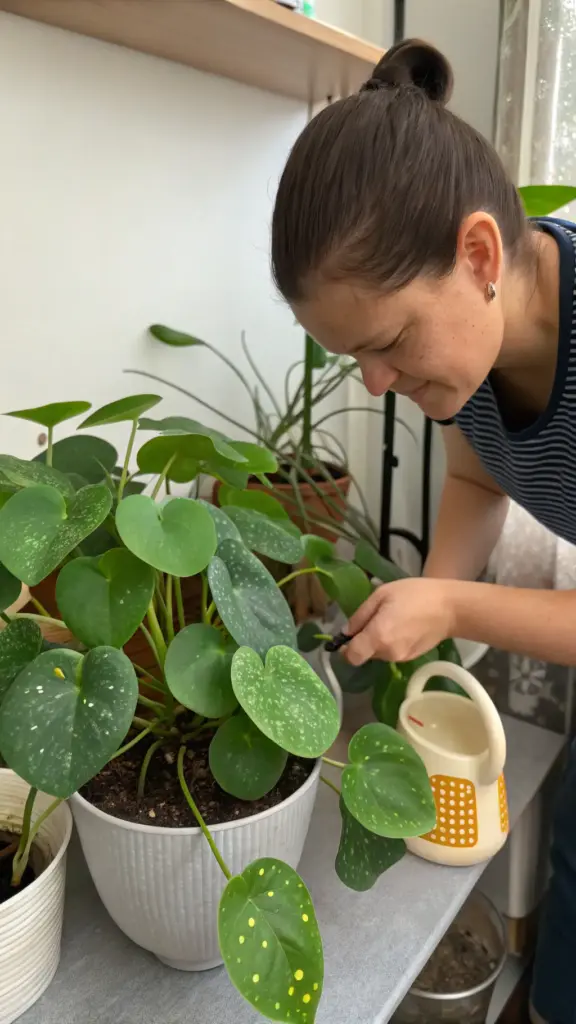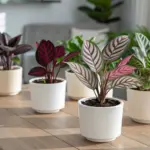5. They Prevent Common Pest Problems Before They Start

Nothing breaks a plant parent’s heart like discovering spider mites have turned your beautiful Chinese money plant into a web-covered disaster. I learned this lesson the hard way when I lost two plants in one week.
The worst part? I could have prevented the whole mess if I’d known what nursery owners do differently.
Prevention is literally 100 times easier than treatment when it comes to plant pests. Trust me on this one!
Early Detection Saves Everything
I check my plants every single time I water them now – it takes maybe 30 seconds but catches problems before they explode. Spider mites leave tiny yellow speckles on leaves that most people miss.
Here’s my weekly inspection routine: I flip over a few leaves and look for tiny moving dots or fine webbing. Early spider mites look like moving dust particles under the leaves.
Aphids are easier to spot but move fast. They’re usually green or black tiny bugs clustered on new growth or leaf stems.
I use my phone’s flashlight to get a better look – those little pests are sneaky and hide in leaf crevices.
Natural Prevention That Actually Works
The best nursery trick I learned? Neem oil spray applied monthly as prevention, not just treatment. I mix 1 teaspoon per quart of water with a drop of dish soap.
I spray this mixture on all my plants once a month, focusing on the undersides of leaves where pests love to hide.
Consistent humidity around 40-50% makes your plants less attractive to spider mites. I use a small humidifier near my plant corner during dry months.
Diatomaceous earth sprinkled on the soil surface creates a barrier that crawling pests hate. Food-grade only – the pool stuff will hurt your plants!
My Quarantine System That Works
Every new plant gets quarantined in my bathroom for 2-3 weeks before joining my collection. I learned this after one infected plant destroyed half my collection.
New plants sit on a separate plant stand where I can monitor them closely. Any signs of pests and they stay isolated longer until I’m 100% sure they’re clean.
I inspect quarantined plants every other day with a magnifying glass – sounds obsessive but it’s saved me so much heartache.
Even plants from “trusted” nurseries get quarantined. You never know what hitchhiked home with your new baby.
Organic Treatments That Don’t Suck
When prevention fails, insecticidal soap is my first line of defense. I make my own with 1 tablespoon of pure castile soap per quart of water.
For stubborn spider mite infestations, I do the shower treatment – literally rinse the whole plant under lukewarm water to wash off the pests.
Rubbing alcohol on a cotton swab works great for spot-treating individual aphids or scale insects. Just dab them directly – they hate it.
Sticky yellow traps catch flying pests before they can lay eggs. I keep a few around my plants year-round now.
Creating a Pest-Hostile Environment
Good air circulation is crucial – I run a small fan near my plants during humid summer months. Stagnant air is like a pest paradise.
I space my plants so air can flow between them instead of cramming them together like I used to. Crowded plants get pest problems faster because bugs can jump between them easily.
Clean plant care tools between plants! I wipe my watering can spout and scissors with rubbing alcohol to avoid spreading problems.
I vacuum around my plant area weekly to pick up any fallen leaves or debris where pests might hide.
My Biggest Pest Prevention Mistake
I used to think over-fertilizing would make my plants stronger against pests. Wrong! Soft, lush growth from too much fertilizer actually attracts more bugs.
Stressed plants are pest magnets but so are overfed plants. Finding that balance took me way too long to figure out.
Now I fertilize very lightly and only during growing season. My plants are healthier and way less attractive to unwanted visitors.
The Inspection Schedule That Changed Everything
Monday plant checks became my weekly ritual. I look for early warning signs while the coffee’s brewing – it’s actually pretty relaxing.
I keep a small notebook where I jot down anything unusual. Patterns emerge when you track this stuff over time.
Catching problems at the “hmm, that’s weird” stage instead of the “oh no, everything’s dying” stage has saved countless plants.
Ready to discover the repotting secrets that keep Chinese money plants thriving for years? Click “next” to learn when and how nursery pros upgrade their plants’ homes without shocking them!









GIPHY App Key not set. Please check settings